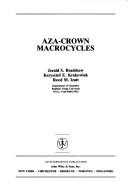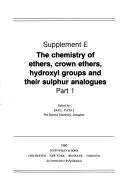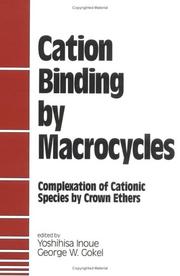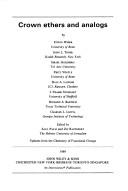| Listing 1 - 10 of 11 | << page >> |
Sort by
|
Book
ISBN: 0851867049 Year: 1994 Publisher: London : Royal society of chemistry,
Abstract | Keywords | Export | Availability | Bookmark
 Loading...
Loading...Choose an application
- Reference Manager
- EndNote
- RefWorks (Direct export to RefWorks)
Crown ethers. --- Macromolecules. --- Ethers
Book
ISBN: 9780306414626 0306414627 Year: 1984 Publisher: New York (N.Y.): Plenum,
Abstract | Keywords | Export | Availability | Bookmark
 Loading...
Loading...Choose an application
- Reference Manager
- EndNote
- RefWorks (Direct export to RefWorks)

ISBN: 0471524859 Year: 1993 Publisher: New York (N.Y.) Wiley
Abstract | Keywords | Export | Availability | Bookmark
 Loading...
Loading...Choose an application
- Reference Manager
- EndNote
- RefWorks (Direct export to RefWorks)
Crown ethers --- Macrocyclic compounds --- Organonitrogen compounds
Book
ISBN: 1483290875 0444881913 1322268797 9780444881915 Year: 1992 Publisher: Amsterdam New York Elsevier
Abstract | Keywords | Export | Availability | Bookmark
 Loading...
Loading...Choose an application
- Reference Manager
- EndNote
- RefWorks (Direct export to RefWorks)
Since the discovery of crown ethers by Pedersen in 1967, several thousands of crown ethers and analogous compounds have been synthesized. Their specific characteristics have been investigated and a variety of applications developed. These developments have led to new fields of chemistry called host-guest chemistry and supramolecular chemistry. This book presents the state-of-the-art of the chemistry of crown ethers and analogous compounds. The first chapter provides an orientation in the new fields of chemistry. Chapter 2 reviews advances in synthetic procedures for crown ethers and analogous
Crown ethers. --- Macromolecules. --- Molecules --- Supramolecular chemistry --- Macrocyclic polyethers --- Ethers --- Ionophores --- Ligands --- Macrocyclic compounds

ISBN: 0471277711 047127772X Year: 1980 Volume: E Publisher: Chichester Wiley
Abstract | Keywords | Export | Availability | Bookmark
 Loading...
Loading...Choose an application
- Reference Manager
- EndNote
- RefWorks (Direct export to RefWorks)
Crown ethers --- Ethers --- Hydroxyl group --- Thiols --- Mercaptans --- Mercapto compounds --- Thiol alcohols --- Organosulfur compounds --- Group, Hydroxyl --- Hydroxyl radical --- Radicals (Chemistry) --- Organic compounds --- Macrocyclic polyethers --- Ionophores --- Ligands --- Macrocyclic compounds

ISBN: 0824781872 9780824781873 Year: 1990 Publisher: New York (N.Y.): Dekker,
Abstract | Keywords | Export | Availability | Bookmark
 Loading...
Loading...Choose an application
- Reference Manager
- EndNote
- RefWorks (Direct export to RefWorks)
Crown ether complexation --- Cation-macrocycle complexes --- Lariat ethers --- Ionophores --- Mixed-donor macrocycles --- Macrocyclic complexes --- Calixarenes in cation complexation --- Complex compounds. --- Crown ethers. --- Cations.
Book
ISBN: 1560810246 3527280731 Year: 1992 Publisher: New York VCH
Abstract | Keywords | Export | Availability | Bookmark
 Loading...
Loading...Choose an application
- Reference Manager
- EndNote
- RefWorks (Direct export to RefWorks)
Descriptive organic chemistry --- 541.64 --- Crown ethers --- Macrocyclic compounds --- #WSCH:LOSA --- Compounds, Macrocyclic --- Macrocycles (Chemistry) --- Heterocyclic compounds --- Macromolecules --- Macrocyclic polyethers --- Ethers --- Ionophores --- Ligands --- Macromolecular chemistry. Polymerization products. Polycondensation products. Polyaddition products --- Crown ethers. --- Macrocyclic compounds. --- 541.64 Macromolecular chemistry. Polymerization products. Polycondensation products. Polyaddition products

ISBN: 0471917079 Year: 1989 Publisher: New York (N.Y.): Wiley
Abstract | Keywords | Export | Availability | Bookmark
 Loading...
Loading...Choose an application
- Reference Manager
- EndNote
- RefWorks (Direct export to RefWorks)
Crown ethers --- 541.64 --- #WSCH:MODS --- Macrocyclic polyethers --- Ethers --- Ionophores --- Ligands --- Macrocyclic compounds --- Macromolecular chemistry. Polymerization products. Polycondensation products. Polyaddition products --- 541.64 Macromolecular chemistry. Polymerization products. Polycondensation products. Polyaddition products
Book
Year: 2021 Publisher: Basel, Switzerland MDPI - Multidisciplinary Digital Publishing Institute
Abstract | Keywords | Export | Availability | Bookmark
 Loading...
Loading...Choose an application
- Reference Manager
- EndNote
- RefWorks (Direct export to RefWorks)
This Special Issue is one of the first for the new MDPI flagship journal Chemistry (ISSN 2624-8549) which has a broad remit for publishing original research in all areas of chemistry. The theme of this issue is Supramolecular Chemistry in the 3rd Millennium and I am sure that this topic will attract many exciting contributions. We chose this topic because it encompasses the unity of contemporary pluridisciplinary science, in which organic, inorganic, physical and theoretical chemists work together with molecular biologists and physicists to develop a systems-level understanding of molecular interactions. The description of supramolecular chemistry as ‘chemistry beyond the molecule’ (Jean-Marie Lehn, Nobel Lecture and Gautam R. Desiraju, Nature, 2001, 412, 397) addresses the wide variety of weak, non-covalent interactions that are the basis for the assembly of supramolecular architectures, molecular receptors and molecular recognition, programed molecular systems, dynamic combinatorial libraries, coordination networks and functional supramolecular materials. We welcome submissions from all disciplines involved in this exciting and evolving area of science.
Technology: general issues --- anion binding --- chloride receptor --- switchable system --- hydroquinone --- redox switch --- metal-organic frameworks --- vapour sorption --- solvatochromism --- desorption kinetics --- ion-channels --- crown-ethers --- bilayer membranes --- self-assembly --- supramolecular chemistry --- host-guest chemistry --- coordination cage --- catalysis --- crystal structure --- copper chloride complexes --- H-bonding pattern --- tetrazole ligands --- X-ray diffraction --- Hirshfeld surfaces --- uranium(VI) --- carboxylates --- capsules --- structure --- luminescence --- multicomponent cocrystal --- cocrystallization mechanism --- cocrystal synthesis --- crystal engineering --- porous material --- molecular recognition --- halogen bond --- co-crystal --- molecular tecton --- binary solid --- network structure --- σ-hole --- molecular electrostatic potential --- calixarenes --- coordination clusters --- manganese --- molecular magnetism --- host-guest interaction --- cucurbit[7]uril --- 4-pyrrolidinopyridinium --- copper complexes --- chlorido ligand displacement --- catalysis regulation --- Schiff base ligands --- urea hydrolysis --- coordination chemistry --- hydrogen bonds --- metalla-assemblies --- coordination-driven self-assembly --- orthogonality --- ligands --- metal ions --- complementarity --- hydrogen bonding --- cyclotricatechylene --- metal-organic cage --- helicate --- metallosupramolecular --- chirality --- copper(II) complexes --- pyrazolato ligands --- supramolecular assembly --- X-ray crystallography --- magnetic susceptibility --- EPR spectroscopy --- isotropic exchange --- antisymmetric exchange --- dipolar interaction --- DFT calculations --- hydrogen bond --- pyrazine --- chloropyrazine --- chloropyrazin-2-amine --- copper halide --- supramolecular structure --- conformational polymorphism --- intermolecular contacts --- N,N',N",N‴-Tetraisopropylpyrophosphoramide --- pyrophosphoramide --- synthons --- supramolecular motifs --- anion binding --- chloride receptor --- switchable system --- hydroquinone --- redox switch --- metal-organic frameworks --- vapour sorption --- solvatochromism --- desorption kinetics --- ion-channels --- crown-ethers --- bilayer membranes --- self-assembly --- supramolecular chemistry --- host-guest chemistry --- coordination cage --- catalysis --- crystal structure --- copper chloride complexes --- H-bonding pattern --- tetrazole ligands --- X-ray diffraction --- Hirshfeld surfaces --- uranium(VI) --- carboxylates --- capsules --- structure --- luminescence --- multicomponent cocrystal --- cocrystallization mechanism --- cocrystal synthesis --- crystal engineering --- porous material --- molecular recognition --- halogen bond --- co-crystal --- molecular tecton --- binary solid --- network structure --- σ-hole --- molecular electrostatic potential --- calixarenes --- coordination clusters --- manganese --- molecular magnetism --- host-guest interaction --- cucurbit[7]uril --- 4-pyrrolidinopyridinium --- copper complexes --- chlorido ligand displacement --- catalysis regulation --- Schiff base ligands --- urea hydrolysis --- coordination chemistry --- hydrogen bonds --- metalla-assemblies --- coordination-driven self-assembly --- orthogonality --- ligands --- metal ions --- complementarity --- hydrogen bonding --- cyclotricatechylene --- metal-organic cage --- helicate --- metallosupramolecular --- chirality --- copper(II) complexes --- pyrazolato ligands --- supramolecular assembly --- X-ray crystallography --- magnetic susceptibility --- EPR spectroscopy --- isotropic exchange --- antisymmetric exchange --- dipolar interaction --- DFT calculations --- hydrogen bond --- pyrazine --- chloropyrazine --- chloropyrazin-2-amine --- copper halide --- supramolecular structure --- conformational polymorphism --- intermolecular contacts --- N,N',N",N‴-Tetraisopropylpyrophosphoramide --- pyrophosphoramide --- synthons --- supramolecular motifs
Book
Year: 2021 Publisher: Basel, Switzerland MDPI - Multidisciplinary Digital Publishing Institute
Abstract | Keywords | Export | Availability | Bookmark
 Loading...
Loading...Choose an application
- Reference Manager
- EndNote
- RefWorks (Direct export to RefWorks)
This Special Issue is one of the first for the new MDPI flagship journal Chemistry (ISSN 2624-8549) which has a broad remit for publishing original research in all areas of chemistry. The theme of this issue is Supramolecular Chemistry in the 3rd Millennium and I am sure that this topic will attract many exciting contributions. We chose this topic because it encompasses the unity of contemporary pluridisciplinary science, in which organic, inorganic, physical and theoretical chemists work together with molecular biologists and physicists to develop a systems-level understanding of molecular interactions. The description of supramolecular chemistry as ‘chemistry beyond the molecule’ (Jean-Marie Lehn, Nobel Lecture and Gautam R. Desiraju, Nature, 2001, 412, 397) addresses the wide variety of weak, non-covalent interactions that are the basis for the assembly of supramolecular architectures, molecular receptors and molecular recognition, programed molecular systems, dynamic combinatorial libraries, coordination networks and functional supramolecular materials. We welcome submissions from all disciplines involved in this exciting and evolving area of science.
Technology: general issues --- anion binding --- chloride receptor --- switchable system --- hydroquinone --- redox switch --- metal-organic frameworks --- vapour sorption --- solvatochromism --- desorption kinetics --- ion-channels --- crown-ethers --- bilayer membranes --- self-assembly --- supramolecular chemistry --- host–guest chemistry --- coordination cage --- catalysis --- crystal structure --- copper chloride complexes --- H-bonding pattern --- tetrazole ligands --- X-ray diffraction --- Hirshfeld surfaces --- uranium(VI) --- carboxylates --- capsules --- structure --- luminescence --- multicomponent cocrystal --- cocrystallization mechanism --- cocrystal synthesis --- crystal engineering --- porous material --- molecular recognition --- halogen bond --- co-crystal --- molecular tecton --- binary solid --- network structure --- σ-hole --- molecular electrostatic potential --- calixarenes --- coordination clusters --- manganese --- molecular magnetism --- host–guest interaction --- cucurbit[7]uril --- 4-pyrrolidinopyridinium --- copper complexes --- chlorido ligand displacement --- catalysis regulation --- Schiff base ligands --- urea hydrolysis --- coordination chemistry --- hydrogen bonds --- metalla-assemblies --- coordination-driven self-assembly --- orthogonality --- ligands --- metal ions --- complementarity --- hydrogen bonding --- cyclotricatechylene --- metal–organic cage --- helicate --- metallosupramolecular --- chirality --- copper(II) complexes --- pyrazolato ligands --- supramolecular assembly --- X-ray crystallography --- magnetic susceptibility --- EPR spectroscopy --- isotropic exchange --- antisymmetric exchange --- dipolar interaction --- DFT calculations --- hydrogen bond --- pyrazine --- chloropyrazine --- chloropyrazin-2-amine --- copper halide --- supramolecular structure --- conformational polymorphism --- intermolecular contacts --- N,N′,N″,N‴-Tetraisopropylpyrophosphoramide --- pyrophosphoramide --- synthons --- supramolecular motifs --- n/a --- host-guest chemistry --- host-guest interaction --- metal-organic cage --- N,N',N",N‴-Tetraisopropylpyrophosphoramide
| Listing 1 - 10 of 11 | << page >> |
Sort by
|

 Search
Search Feedback
Feedback About UniCat
About UniCat  Help
Help News
News